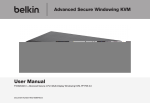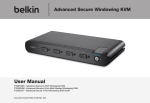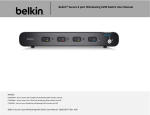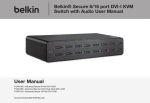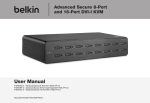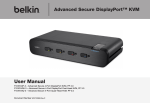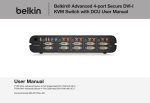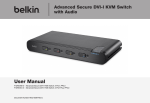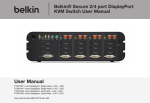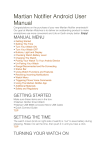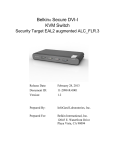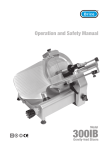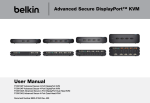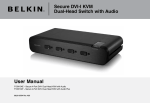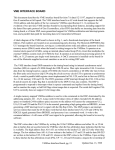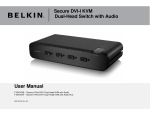Download User Manual - Belkin Business
Transcript
Advanced Secure Windowing KVM User Manual F1DN204M-3 – Advanced Secure 4-Port Multi-Display Windowing KVM, PP 3.0 Document Number HDC10388 Rev.C Table of Contents Table of Contents SECTIONS 1 2 3 4 5 6 Operation . . . . . . . . . . . . . . . . . . . . . . . . . . . . . . . . . . . . . . . . . . . . . . . 26 Operating Modes . . . . . . . . . . . . . . . . . . . . . . . . . . . . . . . . . . . . . . . . 27 List of Available Actions . . . . . . . . . . . . . . . . . . . . . . . . . . . . . . . . . . . 28 Functions and Features . . . . . . . . . . . . . . . . . . . . . . . . . . . . . . . . . . . 33 Introduction . . . . . . . . . . . . . . . . . . . . . . . . . . . . . . . . . . . . . . . . . . . . . 1 What is a Windowing KVM? . . . . . . . . . . . . . . . . . . . . . . . . . . . . . . . . 1 Package Contents . . . . . . . . . . . . . . . . . . . . . . . . . . . . . . . . . . . . . . . . 1 Safety Precautions . . . . . . . . . . . . . . . . . . . . . . . . . . . . . . . . . . . . . . . . 2 User Guidance & Precautions . . . . . . . . . . . . . . . . . . . . . . . . . . . . . . . 3 Troubleshooting . . . . . . . . . . . . . . . . . . . . . . . . . . . . . . . . . . . . . . . . . 37 Overview . . . . . . . . . . . . . . . . . . . . . . . . . . . . . . . . . . . . . . . . . . . . . . . . 5 Security Features . . . . . . . . . . . . . . . . . . . . . . . . . . . . . . . . . . . . . . . . . 5 Tamper Evident Labels . . . . . . . . . . . . . . . . . . . . . . . . . . . . . . . . . . . . 6 Other Features . . . . . . . . . . . . . . . . . . . . . . . . . . . . . . . . . . . . . . . . . . . 7 Equipment Requirements . . . . . . . . . . . . . . . . . . . . . . . . . . . . . . . . . . 8 System Requirements . . . . . . . . . . . . . . . . . . . . . . . . . . . . . . . . . . . . . 9 Front-Panel Features – F1DN204M-3 . . . . . . . . . . . . . . . . . . . . . . . . 12 Rear-Panel Features – F1DN204M-3 . . . . . . . . . . . . . . . . . . . . . . . . 13 Specifications . . . . . . . . . . . . . . . . . . . . . . . . . . . . . . . . . . . . . . . . . . . . 14 Information . . . . . . . . . . . . . . . . . . . . . . . . . . . . . . . . . . . . . . . . . . . . . 41 FCC Statement . . . . . . . . . . . . . . . . . . . . . . . . . . . . . . . . . . . . . . . . . . . 41 Warranty . . . . . . . . . . . . . . . . . . . . . . . . . . . . . . . . . . . . . . . . . . . . . . . . 41 Reporting Belkin Product Security Vulnerability. . . . . . . . . . . . . . . 44 Installation . . . . . . . . . . . . . . . . . . . . . . . . . . . . . . . . . . . . . . . . . . . . . . 16 Before Installation . . . . . . . . . . . . . . . . . . . . . . . . . . . . . . . . . . . . . . . 16 Installation . . . . . . . . . . . . . . . . . . . . . . . . . . . . . . . . . . . . . . . . . . . . . 19 F1DN204M-3 Typical System Installation . . . . . . . . . . . . . . . . . . . . . 22 Setup . . . . . . . . . . . . . . . . . . . . . . . . . . . . . . . . . . . . . . . . . . . . . . . . . 23 Belkin® Advanced Secure Windowing KVM User Manual i Introduction Table of Contents SECTIONS 1 2 3 5 6 Package Contents Thank you for purchasing The Belkin Advanced Secure Windowing KVM. This product is designed for use in secure defense and intelligence environments across wide security gaps. This third generation Secure Windowing KVM offers multiple security features ensuring that no data will leak between connected computers running at different security levels even if both these computers attempt to attack the KVM. This product provides the highest security safeguards and features that meets today’s and will meet future cyber prevention requirements. • • • • • • This User Manual provides all the details you’ll need to install and operate your new product, and troubleshooting guidance—in the unlikely event of a problem. Belkin Advanced Secure KVM 12V 5A DC Power Supply High Performance 5-button Mouse One set of Interchangeable Port Color Chips One set of Port Naming Labels User Manual Please note: Belkin Secure KVM Products cannot be upgraded, serviced or fixed. What is a Windowing KVM? Important Security Note: If you are aware of a potential security vulnerability while installing or operating this product, we encourage you to contact us immediately at the following e-mail address: [email protected] There are many cases where one computer user needs to work simultaneously with few computers. The Belkin Advanced Secure Windowing KVM is designed to provide users with a native windowing environment across isolated networks. Connected computers may operate on different isolated networks having different security levels without exposing the organization to the risks of information leakage through the KVM. The Belkin Advanced Secure Windowing KVM device uses advanced video processing technology to draw a high-resolution dynamic “mosaic” of images generated by different computer sources. Built-in video source isolation forces unidirectional flow of data through the USB and video ports. The product was designed and certified by National Security agencies. Belkin® Advanced Secure Windowing KVM User Manual 4 Important: This product is equipped with an always-on active antitamper system. Any attempt to open the enclosure may activate the anti-tamper system and render the unit permanently inoperable. If the unit’s enclosure appears disrupted or if all the port LEDs flash continuously, please call Belkin Technical Support at 1 (800) 282-2355 Revision A – Initial Release, 23 Feb 2015 B – Updates to User Guidance, 26 April 2015 C – User Guidance changes, 16 June 2015 1 Introduction Table of Contents SECTIONS 1 2 3 4 5 6 Safety Precautions Please read the following safety precautions carefully before using the product: • The product should be stored and used only in temperature and humidity controlled environments as defined in the product’s environmental specifications. • Before cleaning, disconnect the product from any electrical power supply. • Do not expose the product to excessive humidity or moisture. • Never attempt to open the product enclosure. Any attempt to open the enclosure will permanently damage the product. • Do not store or use for extensive period of time in extreme thermal conditions – it may shorten product lifetime. • The product contains a non-replaceable internal battery. Never attempt to replace the battery or open the enclosure. • Install the product only on a clean secure surface. • This product is equipped with an always-on active anti-tampering system. Any attempt to open the product enclosure will activate the anti-tamper triggers and render the unit inoperable and warranty void. • If the product is not used for a long period of time, disconnect it from electrical power. • If any of the following situations occurs, have the product checked by a qualified service technician: –– Liquid penetrates the product’s case. –– The product is exposed to excessive moisture, water or any other liquid. –– The product is not working well even after carefully following the instructions in this user’s manual. –– The product has been dropped or is physically damaged. –– The product shows obvious signs of breakage or loose internal parts. –– In case of external power supply – If power supply overheats, is broken or damaged, or has a damaged cable. Belkin® Advanced Secure Windowing KVM User Manual 2 Introduction Table of Contents SECTIONS 1 2 3 4 5 6 User Guidance & Precautions Please read the following User Guidance & Precautions carefully before using the product: 1. As product powers-up it performs a self-test procedure. In case of self- test failure for any reason, including jammed buttons, the product will be Inoperable. Self-test failure will be indicated by the following abnormal LED behavior: a. All channel-select LEDs will be turned ON and then OFF; b. A specific, predefined LED combination will be turned ON; c. The predefined LED combination will indicate the problem type (jammed buttons, firmware integrity). Try to power cycle product. If problem persists please contact your system administrator or technical support. 2. Product power-up and RFD behavior: a. By default, after product power-up, the active channel will be computer #1, indicated by the applicable front panel push button LED lit. b. Product Restore-to-Factory-Default (RFD) function is available via a physical control button on rear panel. Use a sharp object or paper clip to hold RFD button pressed for several seconds to initiate an RFD action. c. RFD action will be indicated by front panel LEDs blinking all together. d. When product boots after RFD, keyboard and mouse will be mapped to the active channel #1 and default settings will be restored, erasing all user-set definitions. Belkin® Advanced Secure Windowing KVM User Manual 3. The appropriate usage of peripherals (e.g. keyboard, mouse, display, authentication device) is described in detail in this User Manual’s appropriate sections. Do not connect any authentication device with an external power source to product. 4. For security reasons products do not support wireless keyboards and mice. In any case do not connect wireless keyboard/mouse to product. 5. For security reasons products do not support microphone/line-in audio input. In any case do not connect a microphone to product audio output port, including headsets. 6. Product is equipped with an always-on active anti-tampering system. Any attempt to open product enclosure will activate the anti-tamper system indicated by all channel-select LEDs flashing continuously. In this case, product will be inoperable and warranty void. If product enclosure appears disrupted or if all channel- select LEDs flash continuously, please remove product from service immediately and contact technical support. 7. In case a connected device is rejected in the console port group the user will have the following visual indications: a. When connecting a non-qualified keyboard, the keyboard will be non-functional with no visible keyboard strokes on screen when using the keyboard. b. When connecting a non-qualified mouse, the mouse will be non-functional with mouse cursor frozen on screen. c. When connecting a non-qualified display, the video diagnostic LED will flash green and video will not work. d. When connecting a non-qualified USB device, CAC LED will flash green and USB device will be inoperable. 3 Introduction Table of Contents SECTIONS 1 2 3 User Guidance & Precautions (Con.) 8. Do not connect product to computing devices: a. That are TEMPEST computers; b. That include telecommunication equipment; c. That include frame grabber video cards; d. That include special audio processing cards. 9. Important! Before re-allocating computers to channels, it is mandatory to power cycle product, keeping it powered OFF for more than 1 minute. 10. Product log access and administrator configuration options are described in product Administrator Guide. 11. Authentication session will be terminated once product power is down or user intentionally terminates session. 12. If you are aware of any potential security vulnerability while installing or operating product, please remove product from service immediately and contact us in one of the ways listed in this manual. Belkin® Advanced Secure Windowing KVM User Manual 4 4 5 6 Overview Table of Contents SECTIONS 1 2 3 4 5 6 Security Features Unidirectional data flow: USB, audio and video Product is designed, manufactured and delivered in security-controlled environments. Below is a summary of the main advanced features incorporated in product: Unique hardware architecture components prevent unauthorized data flow, including: • Optical unidirectional data flow diodes in the USB data path that filtrate and reject unqualified USB devices; NIAP PPS Ver. 3.0 compliant Product is designed from scratch to comply with latest NIAP PPS ver. 3.0 standard. Thoroughly tested, product meets international NIAP security requirements and covers latest technologies: • Secure analog audio diodes that prevent audio eavesdropping at TEMPEST level with no support for microphone or any other audio-input device; • Optimized for USB (USB 1.1, 2.0, 3.0 and Type C) to support newest peripherals; • Video path is kept separate from all other traffic, enforcing unidirectional native video flow. EDID emulation is done at power up and blocks all EDID/MCCS writes. For DisplayPort video, filtration of AUX channel exists to reject unauthorized transactions. • Optimized for HDMI and DisplayPort video; • Enables newer protocols such as MHL to support mobile devices and not only computers; Isolation of power domains • Supports modern user interaction modes, such as cursor control, touch-screen, multi-touch, and more. Complete isolation of power domains prevents signaling attacks. Advanced isolation between computers and shared peripherals Secure administrator access & log functions The emulations of keyboard, mouse and display EDID, prevent direct contact between computers and shared peripherals. Product design achieves maximal security by keeping the video path separate with keyboard and mouse switched together, purging keyboard buffer when switching channels. All these features contribute to strong isolation between computer interfaces, maintained even when product is powered off. Product incorporates secure administrator access and log functions to provide auditable trail for all product security events, including battery backup life for anti-tampering and log functions. Non-reprogrammable firmware prevents the ability to tamper with product logic. Belkin® Advanced Secure Windowing KVM User Manual 5 Overview Table of Contents SECTIONS 1 2 3 4 5 Always-on, active anti-tamper system Tamper Evident Labels Active anti-tampering system prevents hardware implants and wireless key-loggers. Any anti-tampering attempt causes isolation of all computers and peripheral devices rendering product inoperable and showing clear indications of tampering event to user. Belkin Secure Switch uses holographic tamper evident labels to provide visual indications in case of enclosure intrusion attempt. Holographic security tamper-evident labels are placed on the enclosure to provide a clear visual indication if product has been opened or compromised. If for any reason the tamper evident seal is missing, appears disrupted, or looks different than the example shown here, please avoid using product and call Belkin Technical Support at: (800) 282-2355. Metal enclosure is designed to resist mechanical tampering with all microcontrollers protected against firmware-read, modification and rewrite. 12345678 Active Anti-Tampering System Belkin Secure Switch is equipped with an alwayson active anti-tampering system. If mechanical intrusion is detected by this system, the Switch will be permanently disabled and LED will blink continuously. Common Access Card (CAC) Belkin Secure Windowing KVM patented CAC Ports enable secure use of not only CAC or smart-card readers but also biometric readers, facerecognition and iris-recognition devices. Separate cables used for this port enable further protection and isolation of this function. If product indication tampered state (all LEDs blinking) - please call Technical Support and avoid using that product Secure Packaging Product Enclosure Warning Label “Tear away” packaging ensures secure delivery of the product as it is routed to the end user. Belkin Secure Switch has the following warning printed next to the location of the product Asset Tag and Tamper Evident labels on product enclosure: Belkin® Advanced Secure Windowing KVM User Manual 6 6 Overview Table of Contents SECTIONS 1 2 3 4 5 6 Other Features The Belkin Advanced Secure Windowing KVM was designed with the user in mind for today’s IT environment. The Secure KVM is designed using real-time video processing to provide a user-friendly windowing environment while keeping connected computers fully isolated. Below is a summary of some key features incorporated into the product. CAC Port Enable/Disable Functions Belkin’s patented Host Detection Function enables simple switching of display, keyboard audio and mouse without disconnecting the user authentication session. This is done through the use of front-panel CAC enable/disable switches. Works simultaneously with up to four isolated networks The user can work with a single display while accessing four isolated networks with different security levels through windows. Advanced Scaling Function The Belkin Advanced Secure Windowing KVM has an advanced scaling function allowing the user to scale the video source 1/2 times and 1/4 times smaller to assure good view and a superb work experience. Users can now fit four full HD sources on a single HD screen by scaling each source, all in real time with no data loss. Real-time and real-quality video Pixel-by-pixel video image. No quality loss, latency, reduced colors, dropped frames or artifacts. Fastest digital video processing technology available in any KVM today. Less than 30-milisecond latency. Scale and Tile Modes The Scale and Tile modes allow users to focus on a main source while viewing the other sources, or the Tile mode allows the user to fit all four sources on a single display. Easy Customization Administrator mode enables easy customization of channels, colors, cursors, task-bar, background etc. User-programmeable buttons enable quick setting of user-defined screen arrangements. Bloomberg Keyboard Support The Belkin Advanced Secure Windowing KVM supports the Bloomberg keyboard through the console PS/2 keyboard jack. CAC Port The Belkin Advanced Secure Windowing KVM supports parallel switching of a wide set of user authentication devices including CAC, smart-card and biometric readers. Audio Support The Belkin Advanced Secure Windowing KVM supports audio-out switching. Microphone switching is not supported to prevent analog leakages through audio ports. Belkin® Advanced Secure Windowing KVM User Manual 7 Overview Table of Contents SECTIONS 1 2 3 4 5 Equipment Requirements Cables Belkin highly recommends the use of Belkin Cable Kits for your product to help ensure superior security and performance. These cables offer the highest quality possible and optimal data transmission. One Cable Kit is required per connected computer. Note: Due to USB signal limitations, the cable length cannot exceed 15 feet (4.6m) unless an active USB extender is used. Belkin DVI-D/USB KVM Cable Kits with audio F1D9012b06 – 6 ft. (1.8m) F1D9012b10 – 10 ft. (3m) F1D9012b15 – 15 ft. (4.6m) Belkin CAC USB A/B Cables F1D9013b06 – 6 ft. (1.8m) Belkin Smart Cables F1D9013b10 – 10 ft. (3m) F1D9008b06 (DVI to VGA Smart Cable, 6') F1D9013b15 – 15 ft. (4.6m) F1D9009b06 (VGA to DVI Smart Cable, 6') F1D9011b06 (USB to DVI-I Smart Cable, 6') F1D9017b06 (DP to DVI Smart Cable, 6') Belkin DP to DVI Cables F2CD002b06-E (DP to DVI) Belkin® Advanced Secure Windowing KVM User Manual 8 6 Overview Table of Contents SECTIONS 1 2 3 4 5 6 System Requirements Operating Systems Notes: Product is compatible with devices running on the following operating systems: • Microsoft Windows ® a. Console USB keyboard and mouse ports are switchable, i.e. you can connect keyboard to mouse port and vice versa. However, for optimal operation it is recommended to connect USB keyboard to console USB keyboard port and USB mouse to console USB mouse port. ® • Red Hat®, Ubuntu® and other Linux® platforms • Mac OS® X v10.3 and higher. b. For security reasons products do not support wireless keyboards. In any case do not connect wireless keyboard to product. Laptop docking stations with DVI or HDMI® display outputs are supported directly (VGA is also supported through the use of a Belkin Smart-Cable). Software installation is not needed on any connected computer. c. Non-standard keyboards, such as keyboards with integrated USB hubs and other USB-integrated devices, may not be fully supported due to security policy. If they are supported, only classical keyboard (HID) operation will be functional. It is recommended to use standard USB keyboards. For the latest compatibility list see the Belkin website www.belkinbusiness.com or contact Belkin support at 1 (800) 282-2355 USB Keyboard console port PS/2 Keyboard console port The Belkin Advanced Secure Windowing KVM USB keyboard console port is compatible with the following types of devices: The Belkin Advanced Secure Windowing KVM PS/2 keyboard console port is compatible with the following types of devices: • Standard USB keyboard; • Standard USB mouse; and • Standard PS/2 keyboard; and • Bar-code readers emulating USB keyboard. • Bar-code readers emulating USB keyboard. Belkin® Advanced Secure Windowing KVM User Manual 9 Overview Table of Contents SECTIONS 1 2 3 4 5 6 USB Mouse console port User Authentication Devices The Belkin Advanced Secure Windowing KVM USB mouse console port is compatible with the following types of devices: The Belkin Advanced Secure Windowing KVM is compatible with the following types of user authentication devices plugged into the product’s CAC Port: • 5-button USB mouse • USB smart-card readers (or Common Access Card readers); Notes: • USB biometric devices (such as fingerprint-recognition devices); or a. Console USB keyboard and mouse ports are switchable, i.e. you can connect keyboard to mouse port and vice versa. However, for optimal operation it is recommended to connect USB keyboard to console USB keyboard port and USB mouse to console USB mouse port. • USB authentication tokens. User Display The Belkin Advanced Secure Windowing KVM is compatible with the following types of user displays: b. Console USB mouse port supports Standard KVM Extender composite device having a keyboard/mouse functions. • DVI-D single-link; • DVI-D dual-link interface that may operate as single-link; c. For security reasons products do not support wireless mice. In any case do not connect wireless mouse to product. • HDMI (adapter to DVI needed); or • DVI-I (in digital interface mode). PS/2 Mouse console port • F1DN 204M-3 supports HD resolutions, The Belkin Advanced Secure Windowing KVM PS/2 mouse console port is compatible with the following types of devices: Notes: Some dual-link DVI-D displays can only operate in dual-link mode. Do not use these displays with F1DN204M-3. Some older displays may cause long delays when switching between normal view mode and full-screen mode. • 5-button PS/2 mouse • Regular PS/2 (using a regular PS/2 mouse might create some limitations and is not recommended) Belkin® Advanced Secure Windowing KVM User Manual 10 Overview Table of Contents SECTIONS 1 2 3 Dual Display Model F1DN204M-3 The F1DN204M-3 model uses two displays. It is preferable that both displays will be the same type and model. Displays must be landscape oriented and installed side by side in close proximity to one another. Displays must be with either 1920x1080 or 1920x1200 native resolution. User Audio Devices Product is compatible with the following types of user audio devices: • Stereo headphones; • Amplified stereo speakers. Note: In any case do not connect a microphone to product audio output port including headsets. Power Supply Use only the Belkin power supply provided with The Belkin Advanced Secure Windowing KVM product. In case of a power supply failure, a replacement unit can be ordered from Belkin. Belkin® Advanced Secure Windowing KVM User Manual 11 4 5 6 Overview Table of Contents SECTIONS 1 2 3 1 2 4 5 6 Front-Panel Features – F1DN204M-3 4 3 5 6 1 LED Indicator 3 Tamper-Evident Seal 5 Name Label Guide 2 Port Selector 4 CAC Enable Switch 6 Color Chip Belkin® Advanced Secure Windowing KVM User Manual 12 Overview SECTIONS Table of Contents 1 2 3 4 5 6 Rear-Panel Features – F1DN204M-3 1 11 12 13 2 14 3 4 5 15 6 7 8 16 9 10 17 18 1 Console USB CAC Reader Port and LED 7 Console PS/2 mouse port 13 Restore to Factory Default 2 DCU port (Non operative, for future use) 8 Computer USB KM port 14 Secondary Display Out port 3 Console Audio out jack 9 Computer audio port 15 Video Diagnostic LED 4 Console USB Mouse Port 10 Computer CAC USB Port 16 Host primary video input port 5 Console USB Keyboard Port 11 Mounting Track 17 Computer Video Input port 6 Console PS/2 keyboard port 12 DC Power Jack 18 Mounting Track Belkin® Advanced Secure Windowing KVM User Manual 13 Overview Table of Contents SECTIONS 1 2 3 4 5 6 Specifications Part No. F1DN204M-3 Console Audio Out 1/8" (3.5mm) stereo jack Enclosure Heavy-duty extruded aluminum enclosure with metal faceplate Input Video Resolution Up to 1920x1200 PC Keyboard/Mouse Ports USB Type-B jack PC CAC Ports USB Type-B jack Power Requirements 12V DC, 5A (maximum) power adapter with center-pin-positive polarity AC Input 100 to 240VAC PC Audio Input 1/8" (3.5mm) stereo jack No. of Secure Channels 4 PC Video Input Port DVI-D single-link female No. of Computers Supported 4 4 Displays Supported 2 x single-link DVI-D display; HDMI interface supported with compatible cable Port-Selectors Push Buttons LED Indicators 4 Operating Temp 32° to 104° F (0° to 40° C) -4° to 140° F (-20° to 60° C) Output (console) video resolution F1DN204M-3 supports up to HD (1920 X 1200 pixels) resolutions Storage Temp Console Keyboard Input USB Type-A female connector or PS/2 Mini-DIN 6-pin female connector Humidity 0-80% RH, non-condensing Dimensions Console Mouse Input USB Type-A female connector or PS/2 Mini-DIN 6-pin female connector 80 (W) x 158 (D) x 34 (H) mm 3.15 (W) x 6.22 (D) x 1.34 (H) inches Weight 1 kg. (2.2 lbs.) Console Audio input jack: 1/8" (3.5mm) stereo female jack Made in Console CAC Input USB Type A Designed in California. Assembled in US with US and Foreign components. Product Life-Cycle 5 years Warranty 3 years Belkin® Advanced Secure Windowing KVM User Manual 14 Overview Table of Contents SECTIONS 1 2 3 Output (Console) Display Resolutions Supported Resolution\Model • 1280x1024 (5:4) • 1600x1200 (4:3) • 1680x1050 (16:10) • 1920x1080 (16:9) • 1920x1200 (16:10) • 2x1920x1080 (16:9) • 2x1920x1200 (16:10) • Belkin® Advanced Secure Windowing KVM User Manual 5 Input (Computers) resolutions supported • 800x600 (4:3) SVGA; F1DN204M-3 1280x800 (16:10) 4 • 1280x1024 (5:4) SXGA; • 1920x1080 (16:9) HD1080; or • 1920x1200 (16:10) WUXGA. 15 6 Installation Table of Contents SECTIONS 1 2 3 4 5 6 Before Installation Unpacking the Product Important: 1. If the unit’s enclosure appears disrupted or if all channel-select LEDs flash continuously, please remove product from service immediately and contact Belkin Technical Support at (800) 282-2355. 2. Do not connect product to computing devices: a. That are TEMPEST computers; b. That include telecommunication equipment; c. That include frame grabber video cards d. That include special audio processing cards. Before opening the product sealed packaging, inspect the seal condition to assure that product was not accessed or tampered with during delivery. If packaging seal looks suspicious, contact the Belkin support team and do not use the product. After removing the seal, inspect packaging contents to verify that the required components are included. See packaging content list on page 2. After the Belkin Advanced Secure Windowing KVM is removed from its packaging, inspect the tamper-evident label to assure that the product is properly sealed. If the label is damaged or missing, contact Belkin support and do not use the product. Where to locate the Belkin Advanced Secure Windowing KVM? The enclosure of the product is designed for desktop or under-the-table configurations. An optional mount kit is available. Product must be located in a secure and well-protected environment to prevent potential attacker access. Belkin® Advanced Secure Windowing KVM User Manual 16 Installation Table of Contents SECTIONS 1 2 3 Consider the following when deciding where to place the Belkin Advanced Secure Windowing KVM: • User access to the front-panel push buttons is typically not required as all user controls are available through the mouse and indications available on screen. • Keyboard and mouse cable length. Cables typically may be extended to a distance of 4.6 meters (15 feet). • Display cable length. The Belkin Advanced Secure Windowing KVM may be extended to around 10 meters without video quality degradation (depends on display and cable quality and must be tested prior to fixed installation). • The location of the computers in relation to the KVM and the length of available KVM cables (typically 1.8 meters) Note: Due to USB and DVI signal limitations, the KVM cable length cannot exceed 4.6 meters (15 feet) unless an active extender is used. Warning: Avoid placing cables near fluorescent lights, airconditioning equipment, RF equipment or machines that create electrical noise (e.g., vacuum cleaners) Belkin® Advanced Secure Windowing KVM User Manual 17 4 5 6 Installation Table of Contents SECTIONS 1 2 3 4 5 6 Display selection considerations Proper selection of user display is critical for the success of any Windowing KVM deployment. The information provided here represents the information gained during evaluation and deployment projects. • Consult Belkin support with specific display models and technical specifications. • DVI-I to VGA converters cannot be used with The Belkin Advanced Secure Windowing KVM as it does not support analog video. • Avoid using old CRT displays. • Some projects invested significant resources in the overall project design and implementation but neglected the display and peripherals. Users may reject the new system if a proper display is not used with the system. As large LCD cost is going down daily, it becomes easier and cheaper to retrofit the user desktop completely during these projects. Dual Display Model F1DN204M-3 • The F1DN204M-3 uses two displays. It is preferable that both displays will be the same type and model. • Displays must be landscape oriented and installed side by side in close proximity to one another. Primary on the left and secondary on the right side. • Proper size of the display is critical. To enable simultaneous work with several windows LCD panels larger than 2inches diagonal are recommended. • Displays must be either 1920x1080 or 1920x1200 native resolution. Touch Screen Support: • Tr y to use the larger LCD size possible (taking the user workstation/table size into consideration). This is supported when single display is connected to Windowing KVM. The Touch Screen models supported are those manufactured by ELO, LG, Dell, Samsung and Sharp. • Check if the display adjusts automatically to resolution changes. This feature is essential to support window maximization. • Native resolution of the display should match output resolutions supported by The Belkin Advanced Secure Windowing KVM. • Display should support DVI input. HDMI can be used with proper DVI to HDMI cable or adapter. In this case check audio-out channels cannot be routed through HDMI. • It is recommended to involve the users in the display selection process during evaluation and initial deployments. Belkin® Advanced Secure Windowing KVM User Manual 18 Installation Table of Contents SECTIONS 1 2 3 4 5 6 Installation Step 1 – Connecting the Console Devices to the Belkin Advanced Secure Windowing KVM Step 2 – Connecting the Computers Connect the computers to The Belkin Advanced Secure Windowing KVM through the following steps: See figure above for connector locations. • Connect the user display. • Connect each computer with KVM cable (DVI and USB or VGA and USB cables — for details on cables, see page 6). A USB cable can be connected to any free USB port on the computer. • Connect the user keyboard (USB or PS/2). • Connect the user mouse (USB or PS/2). Verify that mouse is a 5-buttontype. Note: If a computer has more than one video output connector, first test for video output availability by connecting a display directly to that port. Note: If a USB mouse is connected to the USB keyboard port or if USB keyboard is connected to the USB mouse port, it will not work. Note: The USB cable must be connected directly to a free USB port on the computer with no USB hubs or other devices in between. Note: Keyboards with integrated USB hubs, card-readers, storage devices or multimedia extensions will be either not supported at all or only the keyboard function will operate. • Connect an audio cable to the computer audio output (lime green color) or line output (blue color) jacks. • Connect the user authentication device to the CAC USB port • Connect the user headphones or amplified speakers to The Belkin Advanced Secure Windowing KVM audio output jack. Note: Do not connect a microphone to the Belkin Advanced Secure Windowing KVM audio output port. Belkin® Advanced Secure Windowing KVM User Manual 19 Installation Table of Contents SECTIONS 1 2 3 Step 3 – Power up 5 6 Notice: If during installation as a result of bad output resolution (resolution not supported by display) the video image on the user display is lost it is possible to recover the device through the use of the Restore Factory Defaults switch (see item 17 in page 12). Pressing this switch momentarily will return the Belkin Advanced Secure Windowing KVM to the original production settings including lowest output resolution. • Power up the user display. Select DVI input through the display setup menu if applicable. • Power up the Belkin Advanced Secure Windowing K VM by connecting the DC power plug. Power up will take up to 30 seconds. • Power up the connected computers. For information on how to reset the device to factory defaults, see the Troubleshooting section of this manual. Note: When you power up your computers, the Belkin Advanced Secure Windowing KVM emulates both a mouse and keyboard on each port and allows your computers to boot normally. The computer connected to port “1” will be displayed on the user’s display. Check to see that the keyboard, display, and mouse are working normally. Repeat this check with all occupied ports to verify that all computers are connected and responding correctly. The following process can be performed before or after power up. • If the computer and Belkin Advanced Secure Windowing KVM support user authentication devices, connect another USB cable for the CAC function. A CAC USB cable can be connected to any free USB port on the computer. If you encounter an error, check your cable connections for that computer and reboot. If the problem persists, please refer to the Troubleshooting section in this User Manual. Belkin® Advanced Secure Windowing KVM User Manual 4 20 Installation Table of Contents SECTIONS 1 2 3 Color Code Chip Installation 5 6 Common Access Card (CAC) Configuration and Operation The Belkin Advanced Secure Windowing KVM port-selector buttons can be color-coded for easier identification. Refer to the installation instructions below. CAC connection to the computer requires a separate USB cable connection and allows the user to specify whether there is a CAC required for that specific computer or not. This allows the CAC to be connected and controlled separately from the keyboard, mouse, video and audio. Note: You may have to remove the existing black color chip first. Port Name Label Insert color chip 4 Step 1 – Installation Remove color chip with a standard paperclip 1.1 Using the included USB cable, connect one end of the cable to the computer that requires CAC, and the other end to the CAC port on the KVM Switch that corresponds to the computer. 1.2 Enable CAC for the same port connection in Step 1.1 by switching the CAC switch to the right. 1.3 Repeat steps above for additional computers that require CAC. Note: Make sure that the CAC switch is disabled (left) for all other non-connected CAC systems. Once configured, the CAC connection will be switched only when required by the connected computer. When switching from a CAC enabled port to a non-CAC enabled port, the CAC connection will remain with the last previously selected port where the CAC was set to enable. The included network-name labels can be placed in the area underneath the port-selector buttons for port identification. Blank labels are also provided. Belkin® Advanced Secure Windowing KVM User Manual 21 Installation Table of Contents SECTIONS 1 2 3 4 5 6 F1DN204M-3 Typical System Installation Secondary Display Primary Display Computers Channel 2 Channel 3 Channel 1 Channel 4 Setup 1 2 3 Channel 1 Channel 2 Channel 3 Channel 4 1 2 3 ? Scale Tile 4 Keyboard Belkin® Advanced Secure Windowing KVM User Manual 22 Mouse Audio Installation Table of Contents SECTIONS 1 2 3 4 5 6 Setup Now that the Belkin Advanced Secure Windowing KVM is connected and powered-on it is a good opportunity to setup some operational settings. 4 Note about input resolution setting: Selection of input resolution that does not match the connected computer will result in unreadable image at that window. This may be fixed by entering administrator mode and change input resolution settings or by changing the host resolution. Click on the setup icon at the bottom left side of the screen, the Main Admin Setup windows appear and can be accessed. Details about administrator setup windows: 1 Main Admin Menu Enables selection of System setup window or channel-specific window using the mouse. 2 Channel menu Enables selection of channel input resolution (4 options) and border color from 16 color options. 3 System menu Enables system level settings. Administrator can select: -- Display output resolution from 2/6/8 options; -- Border width from 6 options; -- Task-bar size from 2 options; and -- System cursor type from 4 options. Help menu 2 3 System Channel Channel Channel Channel Setup Move 1 2 3 4 Channel 1 23 4 L: Move Window R: Resize Window L + R: Pan Channel 2 Channel 3 Channel 4 1 2 3 ? Scale F1DN204M Model Display Shown Belkin® Advanced Secure Windowing KVM User Manual Resize Toggle Mode 1 Tile Installation Table of Contents SECTIONS 1 2 3 4 5 6 Notes about display resolution settings: After Installation Checklist -- The Belkin Advanced Secure Windowing KVM channel resolution, selected from the channel menu, determines the size of the channel window. It will not affect the actual resolution projected by the connected computer. Once required settings are set, check the final device product configuration with all connected computers operating: -- The Belkin Advanced Secure Windowing KVM is capable of scaling the image in two possible factors: 2x and 4x allowing the user to fit more information on the same display size. 2. Check that each window is coupled to the proper keyboard and mouse (no cables are crossed between channels). 1. Check that each window is connected to the proper PC and has the required border color. 3. Check that each window is coupled to the proper CAC input (if applicable). -- Selection of resolution higher or lower than resolution range of connected display may result in image loss! In this case, you can change the display to a different type or restore factory defaults. 4. Check that each window is coupled to the proper audio output (if applicable). -- To restore factory default settings, use a paper clip or another sharp object and momentarily press the recessed RFD switch located at the rear side above the DC power jack. 5. Check that all video cable thumb screws are secured. -- See table in "Specifications" on page 14 for supported output resolutions per model. Belkin® Advanced Secure Windowing KVM User Manual 24 Installation SECTIONS Table of Contents 1 2 3 4 5 6 Dual display installation Installation of dual display Multi-Viewer is similar to a single display with the following changes: 2. It is recommended that both displays will be identical type and model. 1. Displays must be either 1920 x 1080 or 1920 x 1200 native resolution. Do not use higher resolution as the image will be shown as a smaller window or will be rescaled (resulting a degradation in the displayed video quality). 4. Left side display must be connected to the primary console display output jack (the right side jack when looking from the rear). 3. Displays should be oriented in landscape. 5. Conversion to VGA monitor is not supported. Primary Display Secondary Display Channel 2 Channel 3 Channel 1 Channel 4 Setup Channel 1 Channel 2 Channel 3 Channel 4 1 2 3 ? Scale Tile F1DN204M-3 scale mode view Belkin® Advanced Secure Windowing KVM User Manual 25 Operation Table of Contents SECTIONS 1 2 3 4 5 6 Operation Self-Test Procedure Front Panel Push-Buttons As product powers-up it performs a self-test procedure. In case of self- test failure for any reason, including jammed buttons, the product will be Inoperable. Self-test failure will be indicated by the following abnormal LED behavior: Following power up, the default channel is #1. The user can select any other channel by pressing the appropriate front panel push button. The mouse cursor will be positioned at the center of the selected • All channel-select LEDs will be turned ON and then OFF; • A specific, predefined LED combination will be turned ON; The currently selected channel is indicated by white color illumination of the appropriate push-button. • The predefined LED combination will indicate the problem type (jammed buttons, firmware integrity). Once a different channel is selected – video, keyboard, mouse, audio follow selected channel. CAC behavior is described above. Try to power cycle product. If problem persists please contact your system administrator or technical support. Now that product, computers and peripherals are connected and powered up, it is ready for use. Default Channel After product boots up, the default active channel will be channel #1. This will be indicated by white color illumination of push-button #1. Product Mapping to Sources Product mapping to sources is indicated by stickers/labels specifying which channel is mapped to which computer. Belkin® Advanced Secure Windowing KVM User Manual 26 Operation Table of Contents SECTIONS 1 2 3 4 5 6 Operating Modes Now that you have connected your console and computers to the Belkin Advanced Secure Windowing KVM, it is ready for use. Default channel after power up is channel #1 as indicated by channel select LED #1 illumination. The device is controllled using the 5-button mouse and display interaction. The use of 5-button mouse enables the user to fully use all standard wheel mouse buttons for application-specific tasks and still operate The Belkin Advanced Secure Windowing KVM specific functions using the two extra side buttons. The user may easily toggle between Normal and System Mode by pressing one of the +/- side buttons. User Mode System Mode Wheel Push = Nothing Wheel Push = Application Specific Wheel Rotate = Cyclic togging between windows Wheel Rotate = Application Specific + Key = Switch to User Mode + Key = Switch to System Mode Left Key = Move window while pressing, brings window to front Left Key = Application Specific - Key = Switch to User Mode - Key = Switch to System Mode Right Key = Change window size (moves bottom right corner) Right Key = Application Specific Belkin® Advanced Secure Windowing KVM User Manual 27 Operation Table of Contents SECTIONS 1 2 3 4 5 6 List of Available Actions KVM Combiner in User mode can be controlled via touch screen, mouse clicks and keyboard shortcuts. Action Touch screen Define Custom Presets in System mode N/A Toggle between System Mode and User Mode Hold uppermost right corner of display for 4 seconds Move between sources (1 to 4) – change active pane Note: sources can also be switched by using the Combiner front panel push buttons Move to Tile Keyboard CTRL | CTRL | F1-F4 Note: CTRL | CTRL | F4 sets the custom preset for Tile mode. CTRL | CTRL | Q will always show the default Tile mode with 4 equally sized panes in display Move to System mode: CTRL | CTRL | O , Move to User mode: CTRL | CTRL | U N/A Press Side Mouse Button In System mode select 1-4 buttons in bottom grey menu Tap pane to select and interact with a specific pane CTRL | CTRL | Channel # (1-4) In Scale mode Tap any of the small panes on the right to make them primary In User mode press on any of the panes In Tile mode use Scroll Wheel Mouse button In Scale mode click 4 times on primary pane to move to Tile mode Belkin® Advanced Secure Windowing KVM User Manual Mouse CTRL | CTRL | Q 28 In System mode Select Tile button in bottom grey menu Operation Table of Contents SECTIONS 1 2 3 4 5 6 Action Touch screen Keyboard Mouse Move to Scale In Tile mode hold lower right corner of display for 4 seconds to move to Scale mode CTRL | CTRL | S In System mode Select Scale button in bottom grey menu Scale panes Touch the midpoint of the vertical or horizontal pane borders and hold while scaling. The window and the content will resize. Move/drag panes In Tile mode touch the upper left corner of a specific pane to move it Resize pane In Tile mode touch the lower right corner of a specific pane to resize window without fitting the content. To fit content use CTRL | CTRL | W Enlarge pane to full screen Connecting Secondary Display in Duplicate Mode CTRL | CTRL | ”-“ : Reduce Scaling CTRL | CTRL | ”+” : Increase Scaling In Tile mode tap 4 times on pane to move to Full screen mode Belkin® Advanced Secure Windowing KVM User Manual Left-Click Mouse button CTRL | CTRL | W: Fit the desktop to the resized pane Press and hold Right-Click Mouse button to resize pane. Maybe only part of the desktop will be displayed (see mouse actions for further resize options). CTRL | CTRL | F: Full Screen CTRL | CTRL | F11| L N/A 29 For Fast scaling use mouse Side button & Scroll wheel while holding pressed Left CTRL button N/A CTRL | CTRL | Z: Goes back to last layout before enlarging pane to Full Screen In Full screen mode tap 4 times to move to Tile mode Press and hold Side mouse button + Scroll wheel to reduce/increase scaling. Double Left-Click Mouse button in System mode N/A Operation Table of Contents SECTIONS Action 1 2 3 Touch screen 4 5 Keyboard 6 Mouse CTRL | CTRL | F11| J | J – Primary display is presented on both displays CTRL | CTRL | F11| K | K - Secondary display is presented on both displays Controlling Content and Order of Displays in Extend Mode CTRL | CTRL | F11| K | J – Switch positions between Primary and Secondary displays. N/A CTRL | CTRL | F11 | J | K - Switch positions back between Primary and Secondary displays. N/A Note: J stands for Primary display. K stands for Secondary display. CTRL | CTRL | P to enter mode Presentation Mode -define a channel that will always appear in Full Screen once selected CTRL | CTRL | X (X=Channel # 1-4), for example channel #1. Channel 1 will be displayed in full screen N/A CTRL | CTRL | Channel # other than X, e.g. channel #2, will move back to Tile Mode N/A CTRL | CTRL | N To move out of Presentation Mode Operate applications in a specific active pane in User mode Normal touch screen behavior Belkin® Advanced Secure Windowing KVM User Manual Normal keyboard behavior 30 Normal mouse behavior Operation Table of Contents SECTIONS 1 2 3 4 5 6 User Mode The Belkin Advanced Secure Windowing KVM enables simultaneous interaction with 4 different computers using a single or dual display, keyboard and mouse. When the user interacts with an application at a specific window, that channel is active and the mouse and keyboard are affecting only that channel. The top left corner of the active channel window is white as an indication. In User Mode there is always one channel which is considered to be active. Mouse, keyboard and audio are mapped to the active channel. • All mouse buttons (and wheel) will function based on the computer-assigned specific role (not affected by the KVM) (the mouse side buttons are used to exit User Mode and switch to System Mode). The user may move to a different channel by: • The task-bar is not shown on user display, buttons are not accessible. • Keyboard is mapped to the active window computer. • Audio output will only be heard from the active computer. • The active window will always be on top of all other windows. 1. Switching first to System Mode. While in System Mode, the cursor will change to the selected System Mode cursor and will enable free movement throughout the display area. Once in System Mode the user may point at another window and use the +/- to make it active. • Pressing + / - (on the side of the mouse) mouse buttons will toggle the Belkin Secure KVM to system mode. • When using a PS/2 (which does not have the side buttons) pressing both right and left buttons at the same time will also toggle the KVM to system mode. 2. Using front-panel push buttons to select a different channel. When the Belkin Advanced Secure Windowing KVM is in User Mode: System Mode • The mouse cursor of the active computer (channel) is controlled by the console mouse. The mouse +/- side buttons trigger cyclic toggling between modes. System mode can be easily identified by the appearance of the title bar/ task-bar at the bottom of the display. • The mouse cursor symbol is generated/controlled by the computer operating system/application. The Belkin Advanced Secure Windowing KVM System Mode enables the user to manage his/her combined desktop and customize it for the job being done. This mode also enables the user to move between windows and to minimize/maximize windows as needed. • Mouse movement is limited to the active window area. Belkin® Advanced Secure Windowing KVM User Manual 31 Operation Table of Contents SECTIONS 1 2 3 In System Mode there is also an active channel, indicated by a white top left corner but the mouse is controlled by the Belkin Advanced Secure Windowing KVM and not mapped to the active channel. 5 6 resolution is larger than the window size). • Pressing and holding the +/- side mouse buttons and moving the mouse wheel will rescale the window (change the size of the input picture). This will be further explained in the scaling part of this manual. When the Belkin Advanced Secure Windowing KVM is in System Mode: • The mouse cursor is controlled by the system mouse. • The mouse cursor is generated/controlled by the Windowing KVM. • Mouse movement is unlimited in all display areas. • The keyboard is routed to the active window (active window is always in front). • Audio output is switched from the active window PC. • Task-bar visible and buttons are accessible. • Pressing + / - mouse buttons will change to User Mode and the active window will be the window where the system cursor was last positioned. • Left-clicking on a window will bring it to the front and make it the active window. Change of Active Window When in System Mode there is always one window, which is considered the active window. The active window’s top left corner will be marked in white (as opposed to black in all other windows) and its icon on the task-bar will show as pressed. The active window is the window to which the keyboard, audio and CAC device are mapped. In User Mode the mouse will also be mapped to this window. Switching between active windows (when in System Mode) is simply done by right-clicking on another window with the mouse cursor. Another option to switch between active windows in System Mode is by using the mouse wheel. Windows will move to the front at a cyclic sequence. Pressing the left mouse button and holding it, will drag the window under it. • Double-clicking on a window will maximize that window to full screen. • Right-clicking on the bottom right corner of a window and dragging will allow changing the window size (limited by the size set under the channel menu). • Pressing both right and left keys on an active window will allow moving the picture inside the window (only applicable if the source Belkin® Advanced Secure Windowing KVM User Manual 4 Moving Between Windows in User Mode When in User Mode, moving between windows can be done either by switching to System Mode (by pressing the mouse side buttons), pointing at the new window and switching back to User Mode (by pressing the mouse side buttons again). Another option is to use the front-panel push buttons. 32 Operation Table of Contents SECTIONS 1 2 3 4 5 6 Functions and Features Dragging a Window Window Internal Scroll In order to move a window, user should first switch to System Mode by pressing + or – mouse side buttons. In System Mode, hold the left mouse button when the system cursor located on the desired window and the window will move. Release left mouse button to drop window in place. When window size is smaller than input image size, it might be required to “move” the image inside the window. This is done by pointing at the window, pressing both mouse buttons at the same time and moving the mouse. Release the mouse buttons to freeze the position of the window. Notes: Window movement to the left side is limited by the display boundary. The “?” button located at the task-bar (see figure below) show mouse functionality bitmap with mouse functions. Help button Window movement to the right side is unlimited (window may be pushed out of the display viewable area). Setup Channel 1 Channel 2 Channel 3 Channel 4 1 2 3 ? Scale Tile Window Resizing In order to resize a window, the user should first switch to System Mode by pressing + or – mouse side buttons. In System Mode, the user should drag the mouse while holding the right mouse button when the system cursor is located on the bottom right corner of the desired window. Release right mouse button to freeze window size. Move Resize Toggle Mode Note: Window size is limited by the size set for the window under the channel menu. L: Move Window R: Resize Window L + R: Pan Belkin® Advanced Secure Windowing KVM User Manual 33 Operation Table of Contents SECTIONS 1 2 3 Maximizing a window to full-screen mode 4 5 6 Note: When the Belkin Advanced Secure Windowing KVM maximizes a window it will change output display resolution to the input resolution. The reaction of this change on the display may change according to the display design. Some displays may automatically adjust to new resolution and rescale (showing full image), while others may not and will show black borders around the image. To maximize a window to its full size, enter System Mode by pressing + or – mouse side buttons, bringing the system cursor to the window that should be maximized, and then double-clicking on that window. The selected window will maximize to its native input resolution. No other windows or bars will be displayed. To leave maximize mode, change back to System Mode (by pressing the mouse side buttons) and rearrange windows as needed. Note: Maximizing a window to full-screen mode in the 204M is slightly different than other models. See detailed explanation below. Note: When using the Belkin Advanced Secure Windowing KVM, it is possible to maximize a window directly from User Mode. Pressing CTRL | CTRL | f will maximize the window in which the user is working. Note: For tile mode press CTRL | CTRL | q For scale mode press CTRL | CTRL | s For system mode press CTRL | CTRL | o For User Mode press CTRL | CTRL | u Belkin® Advanced Secure Windowing KVM User Manual 34 Operation Table of Contents SECTIONS 1 2 3 Deactivating/Activating channels The user can remove inactive channels. In order to deactivate a channel the user should enter System Mode and then move the system cursor to the desired channel button at the task-bar and double-click on it. A red X should appear on that channel (see figure below). In some cases the user may want to deactivate a live channel for operational reasons. The Belkin Advanced Secure Windowing KVM will display instead on that channel a background color. Setup Channel 1 Channel 2 Channel 3 Channel 4 5 6 Dual-display operation Maximizing a window When in System Mode, double-clicking on a window will maximize that window to full screen. If the window is shown on both displays, it will maximize at the display where a larger portion of that window is lying. For example: if 60 percent of the window is at the primary display, it will maximize at the primary. When it is maximizing, the other 40 percent of that window will disappear from the secondary display. The second monitor will still display the same windows as before accessing the fullscreen mode. Any other windows on the display to which the window 1was2 maximized 3 ? will be hidden Scale behind the Tile maximized window. In dual-display mode, the tile function will place channels 1 and 3 windows on the primary display and channels 2 and 4 windows at the secondary display. In this example, channel #1 was deactivated. Repeating this process will cancel this status and reactivate that channel. Once a channel had been deactivated, it would not participate in cyclic toggling between windows and will not be displayed in any way. Belkin® Advanced Secure Windowing KVM User Manual 4 35 Operation Table of Contents SECTIONS 1 2 3 4 5 6 Scale Feature The Belkin Advanced Secure Windowing KVM includes a scaling function. The scaling function allows the user to reduce the size of the source image without losing information, enabling him to see more of the sources on limited screen space. Scaling is done by an advanced scaling algorithm developed by Belkin. By pressing the Scale button on the System Mode task-bar, the screen will be rearranged as follow: Tile Feature Channel 2 The tile feature is accessed from System Mode by clicking on the Tile button located on the task-bar. By pressing Tile the windows be arranged in tile mode but will automatically be scaled by 1:2x factor. For example, if the input source resolution is 1920x1080, the image displayed in the source window will be 960x540. The size of the window is, as always, determined by the output resolution (will be a quarter of the available screen area). Tile is actually a preset of System Mode and, once in tile mode, all System Mode functions are available. Channel 1 Not Scaled Channel 3 1:4 Scaled Channel 4 Setup Channel 1 Channel 2 Channel 3 Channel 4 1 2 3 ? Scale Tile Scale a specific window From System Mode it is possible to scale a specific window simply by pointing on the active window, pressing the mouse side buttons and moving the mouse wheel. User display on the Windowing KVM in Scale mode The active window centered (not scaled) and the other windows will move to the right side and scaled 1:4 times. This will toggle the scaling of the active window between 1:2 times, 1:4 times and no scaling, keeping the actual window frame size fixed. It is still possible in this mode to use all standard System Mode functions to switch active between windows. It is also possible to scale a window (both from System and User Modes by using the CTRL | CTRL | +/- key combination where pressing + will reduce the scaling (from 1:4X to 1:2X and from 1:2X to no scaling) and the – will increase the scaling (from no scaling to 1:2X and from 1:2X to 1:4X). Belkin® Advanced Secure Windowing KVM User Manual Also, once in scale mode moving the mouse wheel will toggle between windows making a different source the central display. Using the front-panel push buttons will change the active window without repositioning the windows. 36 Troubleshooting Table of Contents SECTIONS 1 2 3 4 5 6 General As product powers-up all channel-select LEDs are turned ON and then OFF. After that a specific, predefined LED combination is turned ON. Product is inoperable. Channel select LEDs are blinking. Belkin Advanced Secure Windowing KVM does not work. • Device anti-tampering system was triggered. Change unit and call Belkin technical support. • The product did not pass self-test procedure. Try to power cycle product. If problem persists please contact your system administrator or our technical support. Preset buttons are erased (empty). • Normal behavior if KVM entered into administrator setting mode. No power. No video output, none of the front-panel LEDs are illuminating. Video • Check that the power supply is properly connected to the mains socket. No video image in user display (all channels) • Check that the DC plug is fully inserted into the KVM DC jack. • Check that the display is properly powered. • Check that the connected power supply is the proper one (12V/5A). Do not use power supply from another vendor! • Check that DVI cable is properly secured at both sides. • Check at the display on-screen menu that source selected is DVI • Check that the device is powered-on by using an optical mouse with visible red light. If power is not available, change the power supply. • Check if PC video output mode is DVI. • Connect the display directly to the PC to confirm that video output is available and that good image is shown. How do I restore the factory settings of the Belkin Advanced Secure Windowing KVM? • Restore to factory defaults using the rear-panel recessed switch (see item 16 in the figure at page 11 above). • It is possible to restore the device to its original factory settings through the use of the Restore Factory Defaults switch (see image 17 on page 12). Pressing this switch for 2–3 seconds will return the KVM to the original production settings including lowest output resolution. Belkin® Advanced Secure Windowing KVM User Manual 37 Troubleshooting Table of Contents SECTIONS 1 2 3 No video image in user display (specific channel only). 4 5 6 Window showing background color (no image inside). • Reboot the computer. • Check that the channel is not deactivated by user. • Check that the video cable connecting the computer and KVM is properly secured at both sides. • Check that video cable is connected properly between The Belkin Advanced Secure Windowing KVM and the attached computer. • Check that the PC video output is sent to the connected video connector (if PC supports multiple displays). • Check that the connected computer is powered on/not in display power-saving mode. • Check that the PC resolution matches connected display capabilities. • Connect the display directly to that computer to verify that proper video output is available. • Connect the display directly to the PC to confirm that the video output is available and that a good image is shown. Bad video image quality (some or all channels). • Check that all video cables are inserted properly to the KVM, computer, and display. Window showing smaller image with black borders or bad image. Belkin Secure Windowing KVM channel was connected to a source that is set to a lower resolution than the KVM setting for that channel. • Check that cables are original cables supplied by Belkin. • Adjust source (PC) resolution to match Windowing KVM channel resolution. • With everything connected, power-cycle the Windowing KVM to reset the video. Make sure the Video Diagnostic LED is solid green. • Change channel input resolution in KVM to lower resolution using administrator mode. • Check that the display that you are using supports the resolution and refresh-rate setting on your computer. • Lower the video resolution of your PCs. • Check that the video-cable length does not exceed 4.6m (15 feet). • Connect the display directly into the computer with which you are having trouble to see if the problem still appears. Belkin® Advanced Secure Windowing KVM User Manual 38 Troubleshooting Table of Contents SECTIONS 1 2 3 4 5 6 Keyboard Keyboard and mouse are not working (two channels). Keyboard Caps Lock and Num Lock LEDs are not working. • Check that computer USB and video cables are not crossed (i.e., computer #1 video is connected to KVM port #1 while USB cable is connected to the KVM port #2). • This is a normal behavior. Belkin Secure Windowing KVM blocks all communications from computers to the keyboard to prevent certain potential data leakages. Keyboard does not work (all channels). Certain keyboard functions are not working. • Check that the keyboard you are using is connected properly to the KVM. • Some non-standard keyboard functions are disabled by the KVM to prevent security risks. Contact Belkin support for latest compatibility list. • Check that the USB cable between the KVM and the computer is completely connected. • Try connecting to a different USB port on the computer. • Make sure the keyboard works when directly plugged into the computer (the HID USB driver is installed on the computer). • Rebooting may be necessary when trying this. • Make sure you are not using a wireless keyboard or a keyboard with an integrated USB hub or other USB-integrated devices. These are not supported by the KVM due to security policy. • If the computer is coming out of standby mode, allow up to one minute to regain mouse function. • Try a different keyboard. Belkin® Advanced Secure Windowing KVM User Manual 39 Troubleshooting Table of Contents SECTIONS 1 2 3 Mouse Mouse and keyboard are not working (two channels). • Check that computer USB and video cables are not crossed (i.e., computer #1 video connected to KVM port #1 while USB cable is connected to KVM port #2). Mouse does not work (all channels). • Check that the mouse you are using is connected properly to the KVM. • Check that the USB cable between the KVM and the computer is completely connected. • Try connecting to a different USB port on the computer. • Make sure the mouse works when directly plugged into the computer (the HID USB driver is installed on the computer). • Rebooting may be necessary when trying this. • Make sure you are not using a wireless mouse or a mouse with an integrated USB hub or other USB-integrated devices. These are not supported by the KVM due to security policy. • If the computer is coming out of standby mode, allow up to one minute to regain mouse function. • Try a different mouse. Belkin® Advanced Secure Windowing KVM User Manual 40 4 5 6 Information Table of Contents SECTIONS 1 2 3 4 5 6 FCC Statement Warranty DE C LARAT I ON OF C ONFOR M I T Y W I T H FC C RULES FOR ELECTROMAGNETIC COMPATIBILITY Belkin International, Inc., Limited 3-Year Product Warranty What this warranty covers. We, Belkin International, Inc., of 12045 E. Waterfront Drive, Playa Vista, CA 90094, declare under our sole responsibility that the products comply with Part 15 of the FCC Rules. Operation is subject to the following two conditions: (1) this device may not cause harmful interference, and (2) this device must accept any interference received, including interference that may cause undesired operation. Belkin International, Inc. (“Belkin”) warrants to the original purchaser of this Belkin product that the product shall be free of defects in design, assembly, material, or workmanship. What the period of coverage is? Belkin warrants the Belkin product for three years. CE Declaration of Conformity What will we do to correct problems? We, Belkin International, Inc., declare under our sole responsibility that the products are in conformity with Emissions Standard EN55022 and with Immunity Standard EN55024, LVP EN61000-3-2, and EN61000-3-3. Product Warranty. Belkin will repair or replace, at its option, any defective product free of charge (except for shipping charges for the product). Belkin reserves the right to discontinue any of its products without notice, and disclaims any limited warranty to repair or replace any such discontinued products. In the event that Belkin is unable to repair or replace the product (for example, because it has been discontinued), Belkin will offer either a refund or a credit toward the purchase of another product from Belkin.com in an amount equal to the purchase price of the product as evidenced on the original purchase receipt as discounted by its natural use. ICES This Class B digital apparatus complies with Canadian ICES-003. Cet appareil numérique de la classe B est conforme á la norme NMB-003 du Canada. Belkin® Advanced Secure Windowing KVM User Manual 41 Information Table of Contents SECTIONS 1 2 3 4 5 6 What is not covered by this warranty? All above warranties are null and void if the Belkin product is not provided to Belkin for inspection upon Belkin’s request at the sole expense of the purchaser, or if Belkin determines that the Belkin product has been improperly installed, altered in any way, or tampered with. The Belkin Product Warranty does not protect against acts of God such as flood, lightning, earthquake, war, vandalism, theft, normal-use wear and tear, erosion, depletion, obsolescence, abuse, damage due to low voltage disturbances (i.e. brownouts or sags), non-authorized program, or system equipment modification or alteration. Belkin reserves the right to review the damaged Belkin product. All costs of shipping the Belkin product to Belkin for inspection shall be borne solely by the purchaser. If Belkin determines, in its sole discretion, that it is impractical to ship the damaged equipment to Belkin, Belkin may designate, in its sole discretion, an equipment repair facility to inspect and estimate the cost to repair such equipment. The cost, if any, of shipping the equipment to and from such repair facility and of such estimate shall be borne solely by the purchaser. Damaged equipment must remain available for inspection until the claim is finalized. Whenever claims are settled, Belkin reserves the right to be subrogated under any existing insurance policies the purchaser may have. How to get service To get service for your Belkin product you must take the following steps: 1. Contact Belkin International, Inc., at 12045 E. Waterfront Drive, Playa Vista, CA 90094, Attn: Customer Service, or call toll-free (800)-282-2355, within 15 days of the Occurrence. Be prepared to provide the following information: a. The part number of the Belkin product. b. Where you purchased the product. c. When you purchased the product. d. Copy of original receipt. 2. Your Belkin Customer Service Representative will then instruct you on how to forward your receipt and Belkin product and how to proceed with your claim. Belkin® Advanced Secure Windowing KVM User Manual 42 Information Table of Contents SECTIONS 1 2 3 How state law relates to the warranty. THIS WARRANTY CONTAINS THE SOLE WARRANTY OF BELKIN. THERE ARE NO OTHER WARRANTIES, EXPRESSED OR, EXCEPT AS REQUIRED BY LAW, IMPLIED, INCLUDING THE IMPLIED WARRANTY OR CONDITION OF QUALITY, MERCHANTABILITY OR FITNESS FOR A PARTICULAR PURPOSE, AND SUCH IMPLIED WARRANTIES, IF ANY, ARE LIMITED IN DURATION TO THE TERM OF THIS WARRANTY. Some states do not allow limitations on how long an implied warranty lasts, so the above limitations may not apply to you. IN NO EVENT SHALL BELKIN BE LIABLE FOR INCIDENTAL, SPECIAL, DIRECT, INDIRECT, CONSEQUENTIAL OR MULTIPLE DAMAGES SUCH AS, BUT NOT LIMITED TO, LOST BUSINESS OR PROFITS ARISING OUT OF THE SALE OR USE OF ANY BELKIN PRODUCT, EVEN IF ADVISED OF THE POSSIBILITY OF SUCH DAMAGES. This warranty gives you specific legal rights, and you may also have other rights, which may vary from state to state. Some states do not allow the exclusion or limitation of incidental, consequential, or other damages, so the above limitations may not apply to you. Belkin® Advanced Secure Windowing KVM User Manual 43 4 5 6 Information Table of Contents SECTIONS 1 2 3 Reporting Belkin Product Security Vulnerability. If you are aware of potential security vulnerability with any Belkin Government product, we encourage you to contact us immediately at the following email address: [email protected] or our technical support line at: TOLL FREE 1-800-282-2355 After your communication is received, Belkin Government personnel will contact you to follow up. To ensure confidentiality, Belkin encourages you to use our PGP encryption key. The [email protected] email address is not intended to reach technical support on Belkin Government products or services. Belkin® Advanced Secure Windowing KVM User Manual 44 4 5 6 belkinbusiness.com © 2015 Belkin International, Inc. All rights reserved. All trade names are registered trademarks of respective manufacturers listed. Windows and Windows Vista are either registered trademarks or trademarks of Microsoft Corporation in the United States and/or other countries. Mac OS is a trademark of Apple Inc., registered in the U.S. and other countries.















































